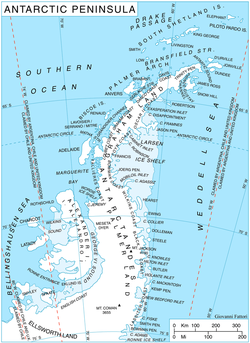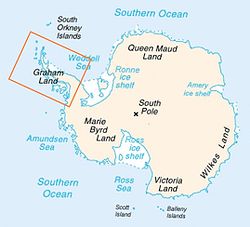
Bellingshausen Sea
Encyclopedia


Antarctic Peninsula
The Antarctic Peninsula is the northernmost part of the mainland of Antarctica. It extends from a line between Cape Adams and a point on the mainland south of Eklund Islands....
, west of Alexander Island
Alexander Island
Alexander Island or Alexander I Island or Alexander I Land or Alexander Land is the largest island of Antarctica, with an area of lying in the Bellingshausen Sea west of the base of the Antarctic Peninsula, from which it is separated by Marguerite Bay and George VI Sound. Alexander Island lies off...
, east of Cape Flying Fish
Cape Flying Fish
Cape Flying Fish is an ice-covered cape which forms the west extremity of Thurston Island. It was discovered by Rear Admiral Byrd and members of the US Antarctic Service in a flight from the Bear in February 1940. Named by US-SCAN for the United States Exploring Expedition ship Flying Fish,...
on Thurston Island
Thurston Island
Thurston Island is an ice-covered, glacially dissected island, long, wide and in area, lying a short way off the NW end of Ellsworth Land, Antarctica. It is the third largest island of Antarctica, after Alexander Island and Berkner Island...
, and south of Peter I Island
Peter I Island
Peter I Island is an uninhabited volcanic island in the Bellingshausen Sea, from Antarctica. It is claimed as a dependency of Norway, and along with Queen Maud Land and Bouvet Island comprises one of the three Norwegian dependent territories in the Antarctic and sub-Antarctic. Peter I Island is ...
(there the southern Vostokkysten). In the south are, from west to east, Eights Coast
Eights Coast
Eights Coast is that portion of the coast of West Antarctica between Cape Waite and Pfrogner Point. To the west is Walgreen Coast of Marie Byrd Land, and to the east is Bryan Coast. It is part of Ellsworth Land and stretches between 103°24'W and 89°35'W. This coast is bordered by Thurston Island,...
, Bryan Coast
Bryan Coast
Bryan Coast is that portion of the coast of Antarctica along the south shore of the Bellingshausen Sea between Pfrogner Point and the northern tip of the Rydberg Peninsula. To the west is Eights Coast, and to the east is English Coast...
and English Coast
English Coast
English Coast is that portion of the coast of Antarctica between the north tip of Rydberg Peninsula and Buttress Nunataks . To the west is Bryan Coast, and northward runs Rymill Coast east of Alexander Island across George VI Sound. This coast was discovered and explored in 1940, on land by Finn...
(west part) of West Antarctica
West Antarctica
West Antarctica, or Lesser Antarctica, one of the two major regions of Antarctica, is the part of the continent that lies within the Western Hemisphere including the Antarctic Peninsula.-Location and description:...
. To the west of Cape Flying Fish joins Amundsen Sea
Amundsen Sea
The Amundsen Sea is an arm of the Southern Ocean off Marie Byrd Land in western Antarctica. It is bounded by Cape Flying Fish, the northwestern tip of Thurston Island to the east and Cape Dart on Siple Island to the west. East of Cape Flying Fish starts the Bellingshausen Sea. West of Cape Dart is...
.
Bellingshausen Sea has an area of 487000 km² (188,031.8 sq mi) and reaches a maximum depth of 4470 metres (14,665.4 ft).
It takes its name from Admiral Thaddeus Bellingshausen, who explored in the area in 1821.
In the late Pliocene Epoch, about 2.15 million years ago, the Eltanin asteroid impacted here. This is the only known impact in a deep-ocean basin in the world.

